I thought I was done writing about Bouffalo Lab BL602 WiFI & Bluetooth RISC-V SoC for a while after first covering the chip itself, and then an inexpensive BL602 development board this weekend.
But the BL602 SDK has shown up in various Github repositories, including Bouffalo Lab’s own bl_iot_sdk repository, and as more people are looking into it, there’s now an effort to develop a fully open-source blob-free WiFi & Bluetooth stack for BL602, and other Bouffalo Lab WiFi and/or Bluetooth wireless chips.
Last day we communicate with Bouffalolab, finally they release the SDK of BL602 (RV32 chip of wifi+bt), all code is open, except libblecontroller.a, libatcmd.a, libbl602_wifi.a (while they have all symbol inside)https://t.co/giHsQ4ezXx
we have a fork too https://t.co/FiaAIxLBc8— Sipeed (@SipeedIO) October 27, 2020
First, Sipeed says the code is mostly open-source except for three libraries: ibblecontroller.a, libatcmd.a, libbl602_wifi.a, all of which are un-obfuscated, and easy to disassemble.
Then we have Pine64 that offers free BL602 “PineCone” development boards to anyone that submits a pull request to help the community obtaining an open-source, blob-free WiFi and BLE stack as part of their Nutcracker Challenge. I find the initiative interesting, but a bit backward, as they ask people to commit code before having the hardware to play with. Hopefully, they’ll find a better way to distribute hardware to developers especially they have 1,000 samples on hand.

I don’t have photos of the PineCone board but only renders. It’s comprised of a breakout board and a BL602 module with the same form factor as the Pine64 PADI IoT stamp.
The company is not yet fully committed to selling the board and module, but if they do they plan to sell the module for $1.99 and PineCone EVB for $3.99.
[Update: photos and schematics
]

Jean-Luc started CNX Software in 2010 as a part-time endeavor, before quitting his job as a software engineering manager, and starting to write daily news, and reviews full time later in 2011.
Support CNX Software! Donate via cryptocurrencies, become a Patron on Patreon, or purchase goods on Amazon or Aliexpress





